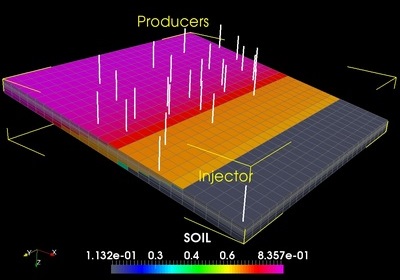9th SPE Comparative Study
Description
 The problem from the SPE-29110 paper is an extended test for three-phase three-dimensional Black-Oil modelling technique. The problem description can be found in: Killough, J.E. 1995 Ninth SPE Comparative Solution Project:
A Reexamination of Black-Oil Simulation. 13th SPE Symposium on Reservoir
Simulation, San Antonio, Feb 12-15, 1995 DOI:10.2118/29110-MS.
The problem involves oil production from a dipping initially undersaturated reservoir. There are 9000 grid blocks in total (rectilinear grid: 24*25*15). The permeability distribution is heterogeneous whereas the porosity distribution is homogeneous in every layer. The dip angle is 10 degrees. The oil-water capillary pressure is exposed to rapid variations under small saturation changes. There are 25 producers and a single water injector which is completed below oil-water contact. The field (and well) oil and gas production rates, bottom-hole pressures, GOR, water cut, pressure and saturation distributions should be reported every 15 days through 900 days of production.
The problem from the SPE-29110 paper is an extended test for three-phase three-dimensional Black-Oil modelling technique. The problem description can be found in: Killough, J.E. 1995 Ninth SPE Comparative Solution Project:
A Reexamination of Black-Oil Simulation. 13th SPE Symposium on Reservoir
Simulation, San Antonio, Feb 12-15, 1995 DOI:10.2118/29110-MS.
The problem involves oil production from a dipping initially undersaturated reservoir. There are 9000 grid blocks in total (rectilinear grid: 24*25*15). The permeability distribution is heterogeneous whereas the porosity distribution is homogeneous in every layer. The dip angle is 10 degrees. The oil-water capillary pressure is exposed to rapid variations under small saturation changes. There are 25 producers and a single water injector which is completed below oil-water contact. The field (and well) oil and gas production rates, bottom-hole pressures, GOR, water cut, pressure and saturation distributions should be reported every 15 days through 900 days of production.
Associated files
| File | Version | Description |
|---|---|---|
| SPE9.RUN | 2015.D | Input file for the 9th SPE Comparative Study. |
| SPE9.PERMX | - | Heterogeneous permeability distribution. |
| SPE9.pvsm | - | ParaView state file for the output visualization and postprocessing. |
Screenshots and animated figures
- Animated figure for the oil/gas/water saturations and pressure;
- Layout 1 of the Paraview SPE9.pvsm file (Permeability distribution, production rates, oil-water saturation functions);
- Layout 2 of the Paraview SPE9.pvsm file (Oil satutation, gas saturation, water saturation and pressure distribution);
- Layout 3 of the Paraview SPE9.pvsm file (Field production rates and totals, gas-oil ratio and water cut).
- Layout 4 of the Paraview SPE9.pvsm file (Parameters for selected wells).
References
- Killough, J.E. 1995 Ninth SPE Comparative Solution Project: A Reexamination of Black-Oil Simulation. 13th SPE Symposium on Reservoir Simulation, San Antonio, Feb 12-15, 1995. DOI: 10.2118/29110-MS.
- Afanasyev, A. 2015 Hydrodynamic modelling of petroleum reservoirs using simulator MUFITS. Energy Procedia. 76: 427-435. DOI:10.1016/j.egypro.2015.07.861.